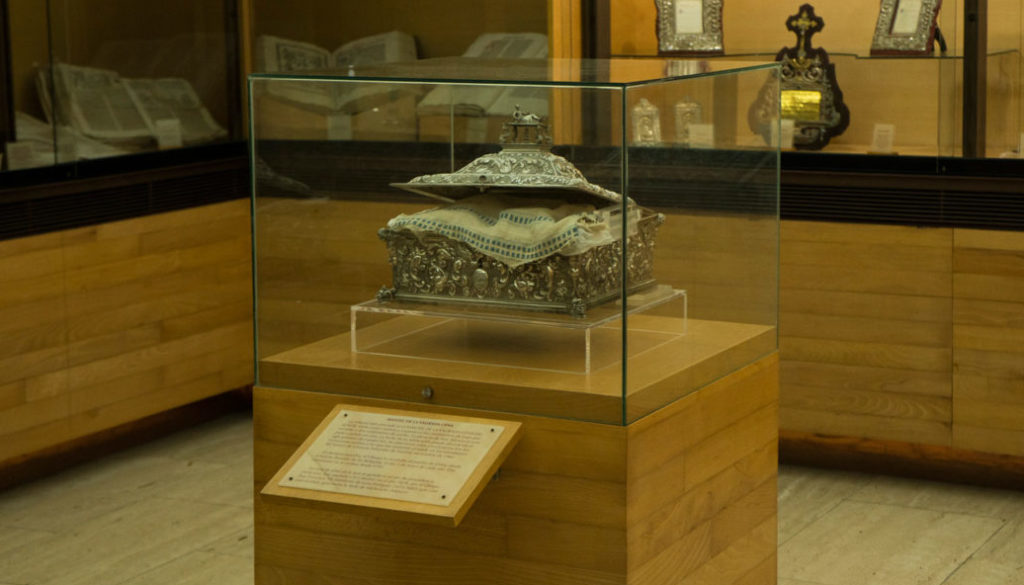 Relics of Our Lord: The Shroud of Turin and the Shroud of Oviedo
Relics of Our Lord: The Shroud of Turin and the Shroud of Oviedo Relics of Our Lord: the Holy Robe of Jesus
Relics of Our Lord: the Holy Robe of Jesus Relics of Our Lord: the holy places
Relics of Our Lord: the holy placesThe tablecloth of the Last Supper is a relic that, according to tradition, covered the table where the Last Supper of Our Lord and the apostles took place. The moment in which Christ established the sacrament of the Eucharist.
As of today, and since the end of the 14th century, it is located in the cathedral of Santa María de la Asunción, Coria, province of Extremadura, Spain.
Given the devotion and religious interest that the tablecloth has always aroused, the cathedral had to be renovated to place the relic in a visible place so that the faithful could contemplate it comfortably and thus contribute to their piety.
We do not have any documentary reference until the beginning of the 15th century, when Benedict XIII - Pope Luna - granted a bull by virtue of which its authenticity was recognized and it was allowed to be worshipped every May 3rd. On that day the cloth was hung from the balcony of the cathedral for veneration.
Such was the devotion that the relic aroused, that for centuries there were huge numbers of processions to ask the Lord for the end of plagues, droughts, floods or other natural disasters or intentions. The cloth was displayed at certain celebrations for public veneration throughout the liturgical year.
This privilege was suppressed at the end of the 18th century when it was considered that certain abuses were taking place on the part of those who venerated the relic. In fact, they were taking pieces of the tablecloth and ostensibly spoiling it. It was decided to remove it from the balcony and place it in an urn, where it remains today.
Such a decision led to the relic being forgotten, and it was only recently that it was decided to revive the popular devotion to the tablecloth of the Last Supper.
Relation of the tablecloth to the Shroud of Turin
Scholars of both relics, the tablecloth of the Last Supper and the Holy Shroud of Turin -to which we referred in the previous fascicle- have guessed a series of coincidences that lead to think that both cloths could well coincide as tablecloths of the table where the Holy Supper of Jesus with the apostles took place.
Among other coincidences, it is worth mentioning the thread that makes up the weft of the tablecloth, which appears twisted in a "Z" shape, which coincides with the shroud.
The dimensions of the tablecloth -length 4.32 m, width 0.90 m- almost coincide with those of the holy sheet -length 4.40 m, width 1.10 m-.
The tablecloth bands are adorned with blue dyed ribbons that, according to the researchers, are from indigo natural, a dye commonly used in ancient times introduced in Europe in the sixteenth century, two centuries after the relic of Coria was discovered. There are also those who affirm that this relic is the tablecloth that Leonardo Da Vinci immortalized in his work "The Last Supper", since in both cases it is decorated with blue bands.
We know that, in the great celebrations - and the Passover was one - the Jews used two tablecloths, one on which the food was placed and the other to protect it. Our Lord was buried quickly, because, as it is concluded from the reading of the holy Gospel, in three hours Joseph of Arimathea had to claim the deceased body to Pilate, to obtain permission to bury him, transfer him to the tomb, shroud him and seal the tomb. Why would he not take a tablecloth before such a pressing situation? A tablecloth that, on the other hand, would be close at hand. The Lord died at about three o'clock and had to be buried before six o'clock the same day, because at that time the Sabbath began, a Jewish holiday during which no physical labor could be performed.











